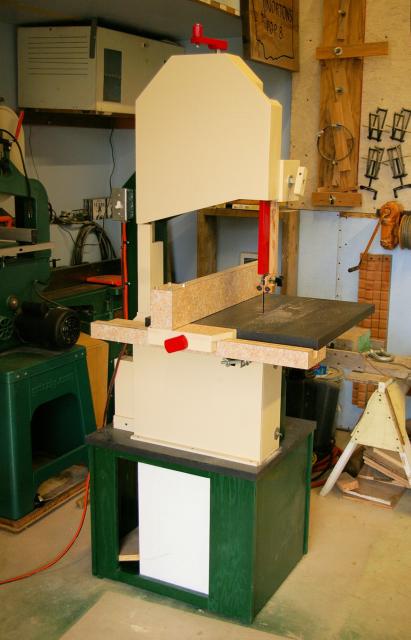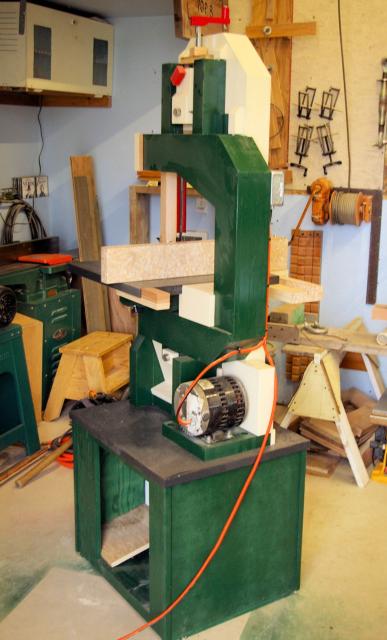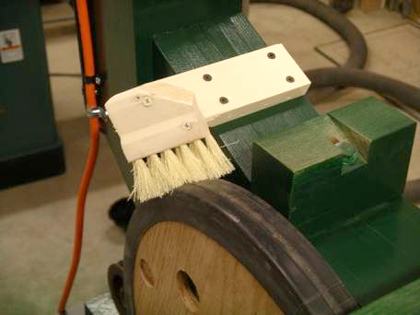Dave Norton's bandsaw


Dave Norton writes about his bandsaw:
Mine is pretty much completely painted except for places where machined metal would be normally.
I used plastic laminate on the table because mostly I
used very used wood on this project except for the frame, which I made with new Douglas fir 1x6.
The guards are only roughly based on your plans, so not exact there. My upper
wheel wobbles a bit but doesn't seem to be a problem.
As with most things of this sort, I made some modifications as I went, to suit
what I wanted. To the vertical portion of the frame I added 3" to the pieces
and made them 1 cm wider for more strength because of the extra length.
 I added a brush for the lower wheel and that is what made for the biggest changes in
the guards, but I like what I came up with. The block on the sloped portion of the
frame is a solid stop for the table. As you can see there is a slot in the block to
allow it to slide up or down the slope to fine tune the table square to the blade.
I added a brush for the lower wheel and that is what made for the biggest changes in
the guards, but I like what I came up with. The block on the sloped portion of the
frame is a solid stop for the table. As you can see there is a slot in the block to
allow it to slide up or down the slope to fine tune the table square to the blade.


Another thing I wanted to do was stabilize the table at the blade removal
slot, so this is what I came up with. The bolts are epoxyed in with
wood filler over the top to smooth the surface. Then of course now I
have the laminate over that.
 And finally I built a rip fence for it. It is made with 11/16" 9 ply Birch plywood.
I did it all out of plywood, figuring it is more seasonally stable. The fence is built
with a strip laid flat top and bottom and two on edge. I glued it all up at once clamped
to the tablesaw table to keep it flat and that worked very well. Then I covered it with
plastic laminate. I have about a 3/4"x1 1/2" wood block that the set bolt pushes against
to lock the fence. I put a little steel plate on the block for the bolt to push against
so I didn't drill a hole in it with the lock bolt. The fence mounts to the locking sled
portion with four bolts so I can adjust it to account for blade drift. I set it square
with the table and haven't had to change it so far. I figure if I'm going to be pushing
hard on the fence I have to clamp the far end down because it moves more than a metal one.
But I'm just being careful and it's fine. I also have a piece of laminate on the
bottom of the fence at the far end for it ride on and to hold it up a bit.
And finally I built a rip fence for it. It is made with 11/16" 9 ply Birch plywood.
I did it all out of plywood, figuring it is more seasonally stable. The fence is built
with a strip laid flat top and bottom and two on edge. I glued it all up at once clamped
to the tablesaw table to keep it flat and that worked very well. Then I covered it with
plastic laminate. I have about a 3/4"x1 1/2" wood block that the set bolt pushes against
to lock the fence. I put a little steel plate on the block for the bolt to push against
so I didn't drill a hole in it with the lock bolt. The fence mounts to the locking sled
portion with four bolts so I can adjust it to account for blade drift. I set it square
with the table and haven't had to change it so far. I figure if I'm going to be pushing
hard on the fence I have to clamp the far end down because it moves more than a metal one.
But I'm just being careful and it's fine. I also have a piece of laminate on the
bottom of the fence at the far end for it ride on and to hold it up a bit.
It seems to do a good job of cutting and the 1 hp motor works well. I just set up a
method to cut small logs (4" to 10") up to 4' or so in length. Now I've started having
trouble. The blade is trying to drift to the right. That's to the right as you are
facing the infeed, or front side. With the system I set up for this, I don't use the
rip fence, but rather clamp on a long board that I have straightened on the jointer.
After several attempts and different fence angles I pulled the stuff off, and with the
rip fence back on, cut a short piece of 2x6 which is 5 1/2" depth of cut. It did with
only about 1/32nd of an inch of variation anywhere on the cut. The practice log was
only about 5 1/2" as well, but the blade drifted so badly that it would stall the motor.
I'm still befuddled. Oh, I also had moved the fence system out of the way so I could
freehand it and it still tried to drift the blade off. I'm using a 1/2" by 3 TPI blade,
but plan to go to a 3/4" by 2 TPI for this kind of thing. However, even that
1/2" blade shouldn't be giving me fits like it is.
So, if you have any help for a poor dumb wood worker...
It was a fun build and I don't regret it a bit.
Dave Norton
Montesano, WA, USA
My response on making deep cuts
Making very deep cuts on a bandsaw is tricky. You need to use light feed
pressure to not exceed the blade's beam strength. More tension increases the beam
strength. And the blade needs to be very sharp, otherwise light feed pressure won't be
enough to get it to cut at all.
I should cover that subject in a future article. Finding the time to do it is the hard part.
 I added a brush for the lower wheel and that is what made for the biggest changes in
the guards, but I like what I came up with. The block on the sloped portion of the
frame is a solid stop for the table. As you can see there is a slot in the block to
allow it to slide up or down the slope to fine tune the table square to the blade.
I added a brush for the lower wheel and that is what made for the biggest changes in
the guards, but I like what I came up with. The block on the sloped portion of the
frame is a solid stop for the table. As you can see there is a slot in the block to
allow it to slide up or down the slope to fine tune the table square to the blade.




 And finally I built a rip fence for it. It is made with 11/16" 9 ply Birch plywood.
I did it all out of plywood, figuring it is more seasonally stable. The fence is built
with a strip laid flat top and bottom and two on edge. I glued it all up at once clamped
to the tablesaw table to keep it flat and that worked very well. Then I covered it with
plastic laminate. I have about a 3/4"x1 1/2" wood block that the set bolt pushes against
to lock the fence. I put a little steel plate on the block for the bolt to push against
so I didn't drill a hole in it with the lock bolt. The fence mounts to the locking sled
portion with four bolts so I can adjust it to account for blade drift. I set it square
with the table and haven't had to change it so far. I figure if I'm going to be pushing
hard on the fence I have to clamp the far end down because it moves more than a metal one.
But I'm just being careful and it's fine. I also have a piece of laminate on the
bottom of the fence at the far end for it ride on and to hold it up a bit.
And finally I built a rip fence for it. It is made with 11/16" 9 ply Birch plywood.
I did it all out of plywood, figuring it is more seasonally stable. The fence is built
with a strip laid flat top and bottom and two on edge. I glued it all up at once clamped
to the tablesaw table to keep it flat and that worked very well. Then I covered it with
plastic laminate. I have about a 3/4"x1 1/2" wood block that the set bolt pushes against
to lock the fence. I put a little steel plate on the block for the bolt to push against
so I didn't drill a hole in it with the lock bolt. The fence mounts to the locking sled
portion with four bolts so I can adjust it to account for blade drift. I set it square
with the table and haven't had to change it so far. I figure if I'm going to be pushing
hard on the fence I have to clamp the far end down because it moves more than a metal one.
But I'm just being careful and it's fine. I also have a piece of laminate on the
bottom of the fence at the far end for it ride on and to hold it up a bit.